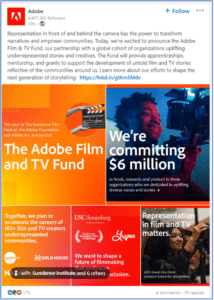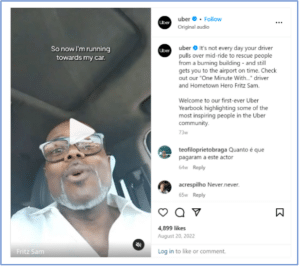Social media has become an indispensable tool for businesses, professional firms, charities and governments, offering a dynamic platform to enhance visibility and engage with diverse audiences. It can help establish your identity, cultivate relationships, improve search engine rankings and drive website traffic.
But to win attention and be competitive and relevant in the fast-paced social media environment, it’s essential to nail social media writing. I learned this working in journalism and corporate communications, where posting on social media platforms is a core part of the job.
Thousands of posts later, here are some strategies and tactics I use to ensure the posts I write for clients (and sometimes myself) hit the mark.
1. Understand your audience and the platforms they use
Before diving into writing social media content, it’s crucial to understand your audience, their interests and online behaviours, and the context of user engagement on different platforms.
Each platform is a unique ecosystem, attracting distinct demographics with varying preferences and behaviours. For instance, Instagram generally appeals to a visually oriented audience, while LinkedIn caters to a more professionally focused demographic.

Figure 1. Different social media platforms appeal to different audiences.
Is your audience seeking information, professional insights or entertainment when logging onto a specific platform? Understanding what your audience is looking for allows you to adapt your writing style to meet those expectations. For example, a casual, conversational tone works well on platforms like X and Facebook. In contrast, a more polished and professional tone is more suitable for LinkedIn.
Analytics tools provided by social media platforms help gain deeper insights into user demographics, audience engagement and the content that works best on those platforms.
2. Maintain a consistent brand voice
While content may vary depending on the social media platform, maintaining a consistent brand voice across platforms is critical.
Brand voice is the language, tone and messaging your company uses to communicate its brand identity and values to customers. A consistent brand voice can help build trust and credibility, increase relatability with target audiences, encourage engagement and differentiate your brand from competitors.
This is where it comes in handy to have a style guide that sets out the rules team members need to follow for external communications.


Figure 2. Technology brand Adobe understands the importance of maintaining a consistent brand voice across platforms, including X (left) and LinkedIn (right).
3. Craft engaging captions
In the fast-paced world of social media, a well-crafted caption can be the difference between someone scrolling past or clicking on a post.
To create captions that resonate with audiences – and prompt individuals to engage with your content – prioritise tone and concision. Clarity and relevance are also important. Ambiguous or overly complex captions risk losing the audience’s attention.
This is something that professional services firms like McKinsey and Ernst & Young do well.


Figure 3. Capture viewers’ attention with a well-crafted caption.
4. Incorporate storytelling elements
Storytelling is a powerful tool that can help connect brands with their target audience on a deeper level. Social media posts are ideal for sharing anecdotes or behind-the-scenes insights relevant to your audience’s interests. It could be a short video with a team member with a great story to tell or photos of a company working bee for a local sustainability group.
These posts can help users connect with your brand, increase engagement or even result in positive publicity. Ride-hailing company Uber, for example, made international headlines when it posted a video on Instagram of driver Fritz Sam recounting how he rescued two people from a burning building mid-ride. (Fritz still got his passenger to the airport on time!)


Figure 4. Uber’s Instagram post and one of the international headlines it inspired.
Emotionally evocative captions that are nostalgic or aspirational, for instance, can also profoundly impact readers and contribute to the overall narrative of your brand.
5. Use hashtags and keywords
Using hashtags and keywords is crucial for enhancing the discoverability of content and increasing the likelihood of social media users interested in the topic finding it.
Choose hashtags that align with your brand and industry to maximise impact. Start by considering your target audience’s interests, what hashtags they might use and what hashtags your competitors use. You can also research popular and trending hashtags with tools like Hashtagify and RiteTag or use social media platforms’ built-in search functions to find relevant hashtags.
Once you’ve identified the hashtags you’re interested in, look at the number of posts and engagement levels for each hashtag to determine its popularity and potential reach. Avoid using generic hashtags that are too broad or overused. Or consider creating a branded hashtag that is unique to your brand and can be used across all your social media platforms.
Notable examples include Apple’s #ShotoniPhone, which has been used 29.4 million times on Instagram; the ALS Association’s #IceBucketChallenge, which resulted in 3.17 million videos being created and raised US$115 million in donations; and Coca-Cola’s #ShareACoke, which led to a 4 per cent increase in sales in Australia.

Figure 5. An Instagram post promoting Apple’s phenomenally successful #ShotoniPhone hashtag campaign.
A word of caution: avoid overloading your posts with too many hashtags, as this can #LookSpammy.
6. Encourage engagement
Engagement is the heartbeat of social media, and encouraging users to interact with your content is vital.
For example, the caption, “Which of these investment strategies do you want to learn more about? #InvestmentAdvice #FinancialGrowth,” introduces the subject and encourages users to offer an opinion. This strategy can help you foster a sense of community and boost the visibility of content through comments and shares. It can also provide valuable insights into users’ preferences.
Other ideas for prompting user engagement include hosting a survey, asking for questions for a live chat and adding clear calls-to-action to posts. Be sure to respond to comments.

Figure 6. Surveys are a great way of inviting audience engagement.
7. Include visual elements to amplify impact
Images and videos are cornerstones of effective social media, amplifying the impact of the written content they accompany. For example, using images in LinkedIn posts results in a 98 per cent higher comment rate than text-only posts.
Visual elements can evoke emotions, tell a story and succinctly communicate brand identity. When integrated seamlessly with thoughtful written content, they can enhance the narrative, reinforce key messages and create a deeper connection between the audience and the content. This can increase brand recall, engagement and shareability on social media platforms.
In addition to images and videos, consider using high-quality graphics, illustrations, animations and infographics to help grab audiences’ attention and increase engagement.


Figure 7. Clever imagery complements the captions in these posts from the NSW Government and Metro Trains Melbourne.
Depending on the purpose of your posts, other types of rich media – such as sound effects, GIFs, interactive elements and social media widgets – might be appropriate. Be sure to tailor content to your target audience’s preferences and the platform you’re using.
8. Use analytics to improve performance
Analytics play a pivotal role in understanding the effectiveness of social media strategies. Regularly analyse performance metrics to identify what resonates with your target audience. Use data-driven insights to refine your social media writing strategy, experimenting with different approaches and building on what works best.
For example, if behind-the-scenes content routinely receives higher engagement, creating more opportunities to lift the curtain on the hidden workings of your business will help drive interest and engagement.
9. Use AI and other writing tools wisely
A growing number of tools powered by artificial intelligence (AI) are available to help users write social media posts and other content. They can be good for writing straightforward posts, such as promoting an event or existing content like articles, webinars or media coverage. But tread warily.
Generative AI tools work by drawing on material already available online, so the copy created is, by its nature, derivative and can be dull. Generative AI can also make things up (‘hallucinate’) when it doesn’t know something. Finding the source of facts and statistics cited by generative AI tools can also be difficult. This means it is vital to check each post’s accuracy before publishing.
Where generative AI tools can be helpful is for getting an overview of a subject or defining standard concepts, generating ideas for posts or headlines, summarising long pieces of text, rewriting copy for different formats, improving grammar and suggesting word choices.
10. Proofread your content
There’s nothing worse than spotting an error after you publish a post. Check your copy several times for typos, spelling mistakes, factual errors and broken links before hitting ‘publish’. Even better, ask someone else to proofread it.
Ultimately, there’s no one-size-fits-all solution for acing social media. But my number one tip is to focus on your customers’ problems, challenges, needs, interests and goals. By consistently addressing your customers’ concerns and aspirations with high-quality content, you can help establish your business’ brand as a trusted resource, strengthen connections and build trust. #Success
By Ylla Watkins
If you would like help creating social media posts, feel free to get in touch.

